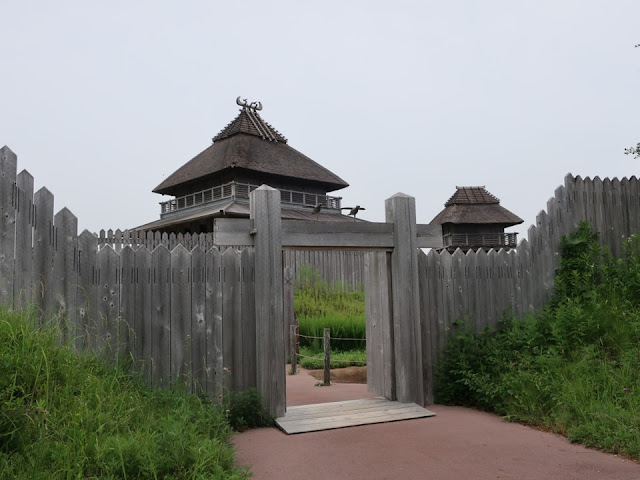Yoshinogari is one of the most famous ruins in Japan. It was revealed during construction of an industrial park. It’s ruins in the Yayoi period (around two thousand years ago), when the rice farming transferred to Japan. People started fighting over rice fields and small countries emerged; some countries dispatched an envoy to an emperor of China.
Yoshinogari
is the site of residences of the ruling class. Therefore,
it’s out of scope of my blog, but we can understand the long and deep
relationship with China and Korea here.
吉野ヶ里は、日本に稲作が伝わった弥生時代の遺跡です。1986年の工業団地造成に伴い、本格的に発掘され、「邪馬台国か!」と話題になった場所です。
弥生時代からは、水田=土地を巡って人々の戦い殺し合いが本格化しました。そして、国ができ、中国に使者を送りました。この遺跡は、支配者階級の住居跡で、稲作の道具は見つかっていますが、水田は発見されていません。
本ブログのテーマである人々の暮らしではないのですが、ご紹介します。中国や朝鮮との長い関係がよく分かりました。
The huge gate suits to the national special historic site. The mascot (lower left) welcomes us.
さすが国の特別史跡、メインゲートは巨大です。マスコットもお迎えしてくれました。
All buildings in the historical park were rebuilt. Let’s proceed into the moat village.
建物はすべて復元されたものです。環濠の内側へと進みます。
Inside the fence, there are a moat and many stakes to protect the village. It’s like a fort.
環濠の内側は、逆茂木で守っています。
South inner palace、南内郭
Let’s go to the south inner palace (Minami-Naikaku). The residences in the 3rd century were reproduced. The two watchtowers intimidate visitors; the long side of the rectangle is at front. A guide said, the short side at front is better to fight with invaders, so they placed a premium on intimidating visitors.
南内郭に向かいます。三世紀頃を再現しています。横長に配置した物見櫓が来場者を威圧しています。戦うなら、縦長にした方が有利だそうです。
At the innermost of the site, there is a fence encircled area; it’s assumed that a king family resided. The king’s residence is not so large, however it has an ornamental ridge beam.
内郭の奥には、更に塀で守られた場所があり、王の一族が住んだ場所だと考えられています。王の家は、特に大きくはないのですが、棟は装飾的です。
The man in center is a king. The man on the right is responsible for foreign affairs. He had a chance to meet a Chinese emperor, so his position was next to the king.
家の中の展示です。中央が王です。なお、右側は外務です。中国皇帝とも会う可能性がある外務は王に次ぐ重要な地位だと考えられていました。
Food was cooked in the kitchen above and was delivered to the residences of the king and other ruling class.
王や支配者(大人/だいじん)のための食事をつくる煮炊き屋もありました。
North inner palace、北内郭
North inner palace (Kita-Naikaku) is considered to be the center of festivals and politics. It says, “it is believed that only the leaders of the province were allowed to enter this sacred area.”
祭祀や政治の中心であった北内郭へと向かいます。「指導者たちだけが出入りできた神聖かつ特別な場所」と書かれています。
The structure of the gateway is complex for preventing a foreign invasion.
入り口の構造は複雑で、守りを固めています。
The main ceremonial hall (center, 16.5-meter-tall), buildings for rituals and watchtowers were reproduced. Those were restored based on the excavations and the study of ancient China, because there aren’t pictures about buildings.
主祭殿(中央、高さ16.5m)や祭祀用の建物、物見櫓が復元されていますが、実物の絵などは残っていなくて、古代中国の事例などを参考に学者さんが推測して復元したものです。
At the second floor, the village leaders had a meeting to decide the date of harvesting rice. The date was probably decided by the growing condition and the divination.
主祭殿の二階では、村々の代表が集まり、稲刈りの日を決める会議の様子が再現されていました。稲の生育具合と占いを元に決めたと考えられるそうです。
At the 3rd floor (top floor), the head priest is receiving a message from an ancestral spirit. It is written that the mirror, the ball and the sword were ritual equipment to exchange messages with the spirit. Those are same as the three sacred treasures which symbolize the Japanese Imperial throne. She sits down facing north.
最上階の三階では、最高司祭者が祖霊のお告げを聞く様子が再現されています。「鏡や玉・剣は、巫女(ふじょ)が、祖霊と交信するための祭具です」と書かれています。三種の神器ですね。北を向いて儀式を行っています。
The grave area is north of the north inner palace. There is a north burial mound which is considered king’s graves. There is also a shrine to pray to ancestors. We can go inside the mound. The casket had a cupper sword and cylindrical glass beads. Those burial goods are also found in the ancient king’s tombs in Northeast China and Korea. What a great influence it gave! Pupils visited, too.
更に北へ進むと甕棺墓列の先に王の墓と考えられる北墳丘墓や祖霊に祈りを捧げる祠堂があります。墳丘墓の中を見学できます。銅剣やガラス管玉が発見された甕棺もあります。中国東北地方や韓国の王墓級の遺跡にもあるもので、いかに大きな影響を受けていたかが分かります。小学生たちも見学していました。
From the northward, there are tombs of former rulers, festival and politic places and residences of rulers. It is a same layout as a Chinese capital. China have influenced Japan since such a long time ago (3rd century).
北側に権力者が集まるというのは、中国の都と同じレイアウトだそうです。3世紀頃から大きな影響を受けていたのですね。
The photo above are cylindrical glass beads (replica) in an exhibition room near the south inner palace. The construction of the industrial park was canceled after swords and beads were excavated. Then, the site was designated as the national special historic site.
南内郭の手前の展示室には、教科書に載っている頭部がない遺骨(戦いで切られたと思われる)や、管玉(複製)が展示されています。剣や管玉が発掘され、大変な遺跡だということになり、工業団地の開発をやめ、本格的に発掘し、国の史跡にしたそうです。
People’s outfits (left) and rulers’ ones (right).
庶民の貫頭衣(左)と、支配階級の衣服(右)。
Visited in
May, 2022
Official
website: https://www.yoshinogari.jp/en/
https://www.yoshinogari.jp/ (in Japanese),
accessed in October, 2022
Previous
post (museum in the same region; Kyushu): Kitsuki
castle town museum、きつき城下町資料館
Next post (museum in the same prefecture): Kyushu Ceramic Museum、九州陶磁文化館

















Comments
Post a Comment